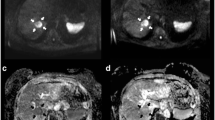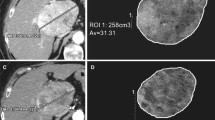Abstract
Purpose
To evaluate the value of quantitative volumetric functional MR imaging in early assessment of response to yttrium-90-labeled (90Y) transarterial radioembolization (TARE) in patients with hypo-vascular liver metastases.
Materials and methods
Seventy four metastatic lesions in 14 patients with hypo-vascular liver metastases after TARE were included in this retrospective study. Diffusion and contrast-enhanced MR imaging was performed before and early after treatment. All MR images were analyzed by two experienced radiologists. Response by anatomic metrics (RECIST, mRECIST, EASL) and functional metrics (ADC and arterial and venous enhancement) were reported in targeted and non-targeted lesions. A two-sample paired t test was used to compare the changes after TARE. A p value of <0.05 was considered statistically significant.
Results
The anatomic metrics did not show any significant changes in both targeted and non-targeted groups. Targeted lesions demonstrated an increase in mean volumetric ADC (23.4%; p = 0.01), a decrease in arterial and venous enhancement (−22.9% and −6.7%, respectively; p < 0.001 and p = 0.002, respectively) 1 month after treatment. Twenty one responding lesions (42%) by RECIST at 6 months demonstrated a significant increase in volumetric ADC (37.2%; p = 0.01), decrease in arterial and venous enhancement (−58.5% and −23.9%, respectively; p < 0.001) at 1 month post-treatment. Responding lesions did not change significantly by anatomic metrics.
Conclusions
RECIST, mRECIST, and EASL criteria failed to stratify lesions into responders and non-responders early after TARE in hypo-vascular liver metastasis. Quantitative volumetric functional MR imaging could be a promising tool as a biomarker for predicting early response and can potentially be utilized in clinical trials.


Similar content being viewed by others
Abbreviations
- TARE:
-
Transarterial radioembolization
- 90Y:
-
Yttrium-90
- RECIST:
-
Response evaluation criteria in solid tumors
- EASL:
-
European association for the study of the liver
- HCC:
-
Hepatocellular carcinoma
- mRECIST:
-
Modified RECIST
- MRI:
-
Magnetic resonance imaging
- DWI:
-
Diffusion-weighted imaging
- ADC:
-
Apparent diffusion coefficient
- LRT:
-
Loco-regional therapy
- NELM:
-
Neuroendocrine liver metastases
- ICLM:
-
Islet cell liver metastases
- TACE:
-
Transarterial chemoembolization
- HAE:
-
Hepatic arterial enhancement
- PVE:
-
Portal venous enhancement
- CR:
-
Complete response
- PR:
-
Partial response
- SD:
-
Stable disease
- PD:
-
Progression of disease
References
Silva AC, Evans JM, McCullough AE, et al. (2009) MR imaging of hypervascular liver masses: a review of current techniques. Radiographics 29(2):385–402
Namasivayam S, Martin DR, Saini S (2007) Imaging of liver metastases: MRI. Cancer Imaging 7:2–9
Cui Y, Zhang XP, Sun YS, Tang L, Shen L (2008) Apparent diffusion coefficient: potential imaging biomarker for prediction and early detection of response to chemotherapy in hepatic metastases. Radiology 248(3):894–900
Halappa VG, Bonekamp S, Corona-Villalobos CP, et al. (2012) Intrahepatic cholangiocarcinoma treated with local-regional therapy: quantitative volumetric apparent diffusion coefficient maps for assessment of tumor response. Radiology 264(1):285–294
Dancey JE, Shepherd FA, Paul K, et al. (2000) Treatment of nonresectable hepatocellular carcinoma with intrahepatic 90Y-microspheres. J Nucl Med 41(10):1673–1681
Jakobs TF, Hoffmann RT, Poepperl G, et al. (2007) Mid-term results in otherwise treatment refractory primary or secondary liver confined tumours treated with selective internal radiation therapy (SIRT) using (90)Yttrium resin-microspheres. Eur Radiol 17(5):1320–1330
Reiner CS, Morsbach F, Sah BR, et al. (2014) Early treatment response evaluation after yttrium-90 radioembolization of liver malignancy with CT perfusion. J Vas Interv Radiol 25(5):747–759
Corona-Villalobos CP, Kamel IR (2014) Functional volumetric MRI in assessing treatment response to intra-arterial therapy of primary and secondary liver tumors. J Comput Assist Tomogr 38(4):513–517
Kamel IR, Reyes DK, Liapi E, Bluemke DA, Geschwind JF (2007) Functional MR imaging assessment of tumor response after 90Y microsphere treatment in patients with unresectable hepatocellular carcinoma. J Vas Interv Radiol 18(1 Pt 1):49–56
Wiering B, Krabbe PF, Jager GJ, Oyen WJ, Ruers TJ (2005) The impact of fluor-18-deoxyglucose-positron emission tomography in the management of colorectal liver metastases. Cancer 104(12):2658–2670
Figueiras RG, Padhani AR, Goh VJ, et al. (2011) Novel oncologic drugs: what they do and how they affect images. Radiographics 31(7):2059–2091
Corona-Villalobos CP, Zhang Y, Zhang WD, Kamel IR (2014) Magnetic resonance imaging of the liver after loco-regional and systemic therapy. Magn Reson Imaging Clin N Am 22(3):353–372
Kamel IR, Bluemke DA, Ramsey D, et al. (2003) Role of diffusion-weighted imaging in estimating tumor necrosis after chemoembolization of hepatocellular carcinoma. AJR Am J Roentgenol 181(3):708–710
Gowdra Halappa V, Corona-Villalobos CP, Bonekamp S, et al. (2013) Neuroendocrine liver metastasis treated by using intraarterial therapy: volumetric functional imaging biomarkers of early tumor response and survival. Radiology 266(2):502–513
Li Z, Bonekamp S, Halappa VG, et al. (2012) Islet cell liver metastases: assessment of volumetric early response with functional MR imaging after transarterial chemoembolization. Radiology 264(1):97–109
Bonekamp S, Li Z, Geschwind JF, et al. (2013) Unresectable hepatocellular carcinoma: MR imaging after intraarterial therapy. Part I. Identification and validation of volumetric functional response criteria. Radiology 268(2):420–430
Vouche M, Kulik L, Atassi R, et al. (2013) Radiological-pathological analysis of WHO, RECIST, EASL, mRECIST and DWI: Imaging analysis from a prospective randomized trial of Y90 ± sorafenib. Hepatology 58(5):1655–1666
Vouche M, Salem R, Lewandowski RJ, Miller FH (2014) Can volumetric ADC measurement help predict response to Y90 radioembolization in HCC? Abdom Imaging. doi:10.1007/s00261-014-0295-6
Grady L (2006) Random walks for image segmentation. IEEE Trans Pattern Anal Mach Intell 28(11):1768–1783
Corona-Villalobos CP, Halappa VG, Bonekamp S, et al. (2015) Functional magnetic resonance imaging response of targeted tumor burden and its impact on survival in patients with hepatocellular carcinoma. Investig Radiol 50(4):283–289
Kamel IR, Bluemke DA (2002) Magnetic resonance imaging of the liver: assessing response to treatment. Top Magn Reson Imaging 13(3):191–200
Assumpcao L, Choti M, Pawlik TM, Gecshwind JF, Kamel IR (2009) Functional MR imaging as a new paradigm for image guidance. Abdom Imaging 34(6):675–685
Llovet JM, Bruix J (2008) Molecular targeted therapies in hepatocellular carcinoma. Hepatology 48(4):1312–1327
Corona-Villalobos CP, Halappa VG, Geschwind JF, et al. (2015) Volumetric assessment of tumour response using functional MR imaging in patients with hepatocellular carcinoma treated with a combination of doxorubicin-eluting beads and sorafenib. Eur Radiol 25(2):380–390
Bonekamp S, Halappa VG, Geschwind JF, et al. (2013) Unresectable hepatocellular carcinoma: MR imaging after intraarterial therapy. Part II. Response stratification using volumetric functional criteria after intraarterial therapy. Radiology 268(2):431–439
Miller FH, Keppke AL, Reddy D, et al. (2007) Response of liver metastases after treatment with yttrium-90 microspheres: role of size, necrosis, and PET. AJR Am J Roentgenol 188(3):776–783
Buijs M, Kamel IR, Vossen JA, et al. (2007) Assessment of metastatic breast cancer response to chemoembolization with contrast agent enhanced and diffusion-weighted MR imaging. J Vasc Interven Radiol 18(8):957–963
Bonekamp D, Bonekamp S, Halappa VG, et al. (2014) Interobserver agreement of semi-automated and manual measurements of functional MRI metrics of treatment response in hepatocellular carcinoma. Eur J Radiol 83(3):487–496
Chapiro J, Wood LD, Lin M, et al. (2014) Radiologic-pathologic analysis of contrast-enhanced and diffusion-weighted MR imaging in patients with HCC after TACE: diagnostic accuracy of 3D quantitative image analysis. Radiology 273(3):746–758
Funding
This study did not receive any funding.
Author information
Authors and Affiliations
Corresponding author
Ethics declarations
Conflict of interest
None of the authors listed (Xiangyu Zhu, Fatemeh Sobhani, Chunmiao Xu; Li Pan, Mounes Aliyari Ghasebeh, Ihab R. Kamel) have conflict of interest.
Ethical approval
All procedures performed in studies involving human participants were in accordance with the ethical standards of the institutional and/or national research committee and with the 1964 Helsinki declaration and its later amendments or comparable ethical standards.
Informed consent
This study was approved by the IRB. Due to the retrospective nature of this study, informed consent was not obtained.
Rights and permissions
About this article
Cite this article
Zhu, X., Sobhani, F., Xu, C. et al. Quantitative volumetric functional MR imaging: an imaging biomarker of early treatment response in hypo-vascular liver metastasis patients after yttrium-90 transarterial radioembolization. Abdom Radiol 41, 1495–1504 (2016). https://doi.org/10.1007/s00261-016-0694-y
Published:
Issue Date:
DOI: https://doi.org/10.1007/s00261-016-0694-y




